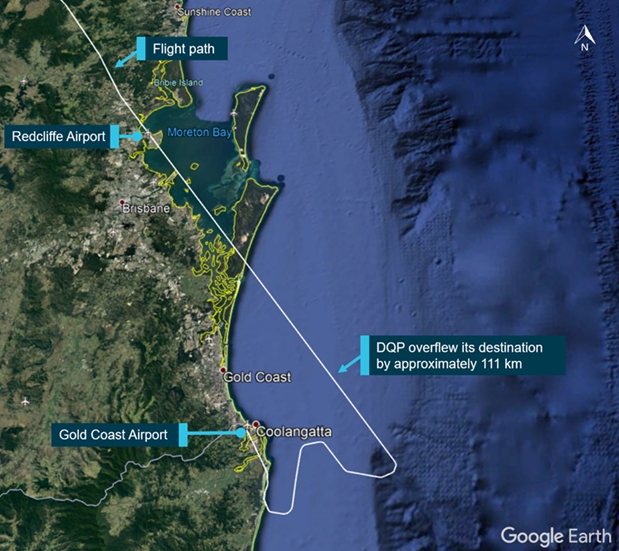
ASN Wikibase Occurrence # 237801
This information is added by users of ASN. Neither ASN nor the Flight Safety Foundation are responsible for the completeness or correctness of this information.
If you feel this information is incomplete or incorrect, you can submit corrected information.
| Date: | Thursday 2 July 2020 |
| Time: | 16:44 LT |
| Type: |  Cessna 208B Grand Caravan |
| Owner/operator: | Private |
| Registration: | VH-DQP |
| MSN: | 208B2069 |
| Year of manufacture: | 2008 |
| Fatalities: | Fatalities: 0 / Occupants: 1 |
| Aircraft damage: | None |
| Category: | Serious incident |
| Location: | near Redcliffe, QLD -
 Australia Australia
|
| Phase: | En route |
| Nature: | Ferry/positioning |
| Departure airport: | Cairns Airport, QLD (CNS/YBCS) |
| Redcliffe Airport, QLD (YRED) | |
| Investigating agency: | ATSB |
| Confidence Rating: |
The pilot was conducting a ferry flight of a Cessna 208B Caravan aircraft from Cairns, Queensland to Redcliffe on the afternoon of 2 July 2020. While cruising at 10,000 feet the pilot encountered unforecast icing conditions and poor visibility due to cloud and climbed to 11,000 feet and began using the aircraft’s supplemental oxygen system intermittently. (Pilots are required to continuously use supplemental oxygen when flying unpressurised aircraft, such as the Caravan, when flying above 10,000 feet.)
When the aircraft was about 53 km west-north-west of Sunshine Coast Airport, air traffic control (ATC) unsuccessfully attempted to contact the pilot regarding their planned descent into Redcliffe.
Following repeated calls to the pilot, ATC enlisted the assistance of pilots in nearby aircraft to contact the Caravan pilot, who was seen to overfly Redcliffe and track towards Brisbane.
The pilot of a Royal Flying Doctor Service Beechcraft B200 King Air aircraft departing Brisbane was asked by ATC to intercept and contact the Caravan pilot, but their initial efforts were unsuccessful. The King Air pilot then dipped their wings and approached the Cessna in an attempt to trigger its traffic alert and collision system (TCAS), but the pilot remained unresponsive.
At 5:35 pm, after 40 minutes without contact and when the aircraft was about 111 km south-south-east of the intended destination, the pilot woke and ATC communications were re-established. The pilot was then instructed to land at Gold Coast Airport, where the aircraft landed safely just after 6pm.
The ATSB found that the pilot was likely experiencing a level of fatigue due to inadequate sleep the night before and leading up to the incident. Further, operating at 11,000 ft with intermittent use of supplemental oxygen likely resulted in the pilot experiencing mild hypoxia. This likely exacerbated the pilot’s existing fatigue and contributed to the pilot falling asleep.
Accident investigation:
 |
|
Sources:
https://www.flightradar24.com/data/aircraft/vh-dqp#24d49f30
https://www.atsb.gov.au/publications/investigation_reports/2020/aair/ao-2020-032/
Images:

Figure: ATSB
Revision history:
| Date/time | Contributor | Updates |
|---|---|---|
| 11-Jul-2020 05:40 | harro | Added |
| 26-May-2021 15:36 | harro | Updated [Photo] |
| 26-May-2021 15:37 | harro | Updated [Narrative] |
Corrections or additions? ... Edit this accident description
The Aviation Safety Network is an exclusive service provided by:


 ©2024 Flight Safety Foundation
©2024 Flight Safety Foundation